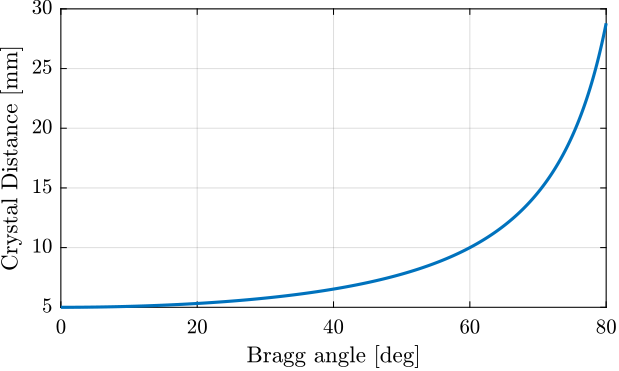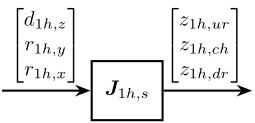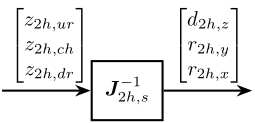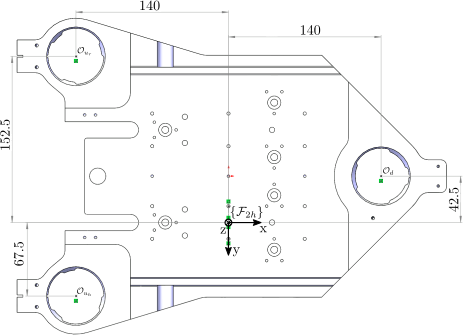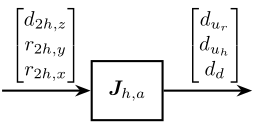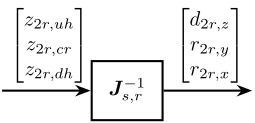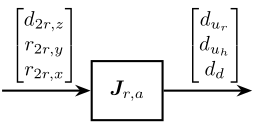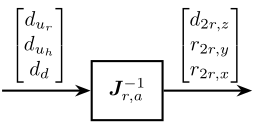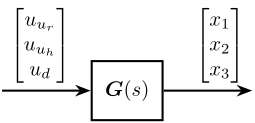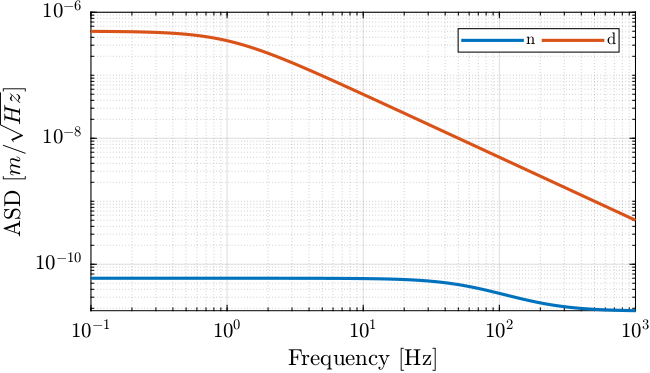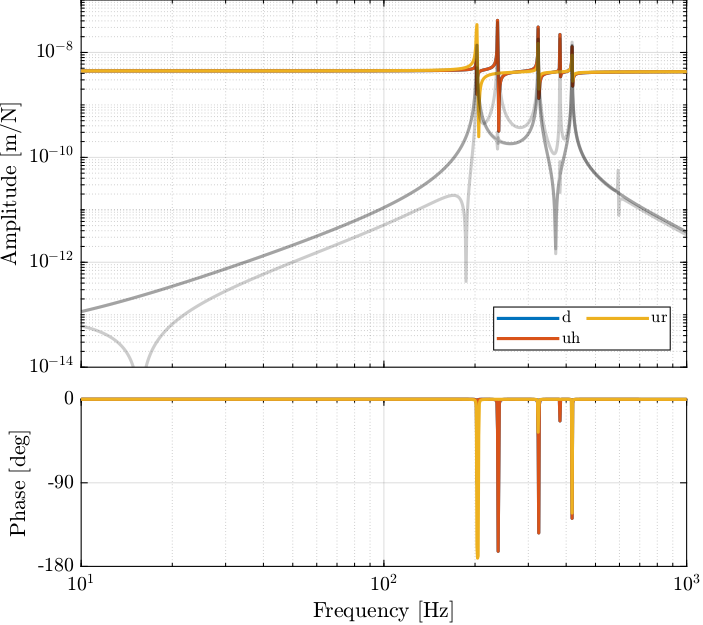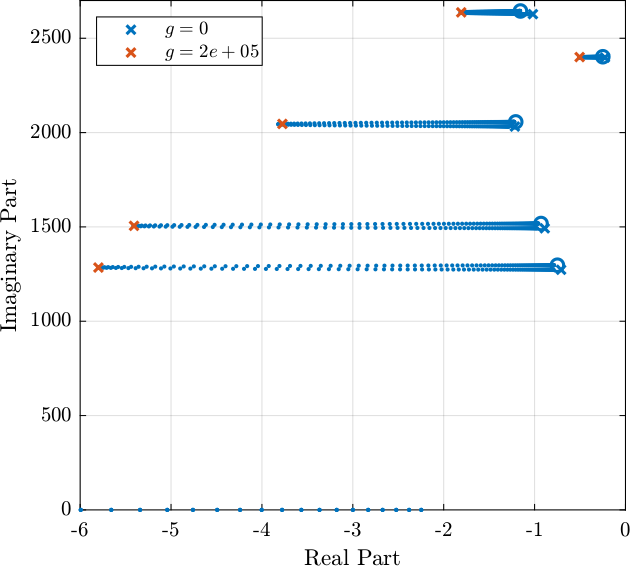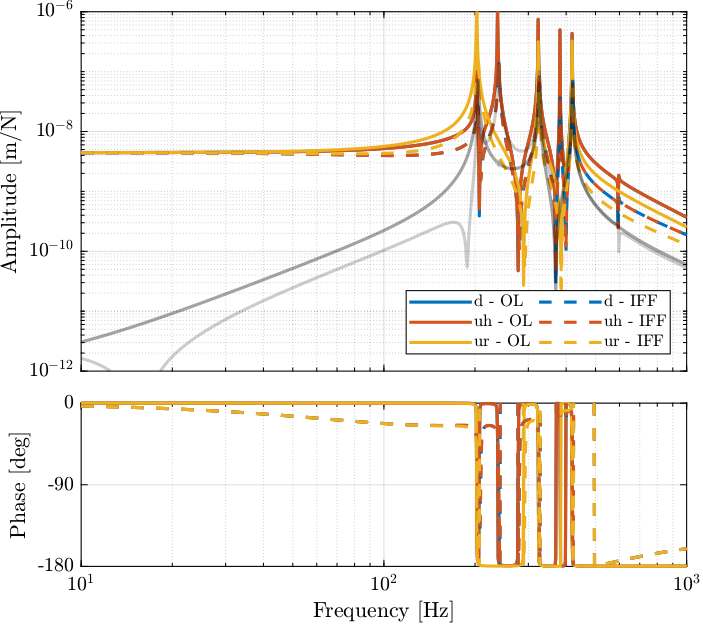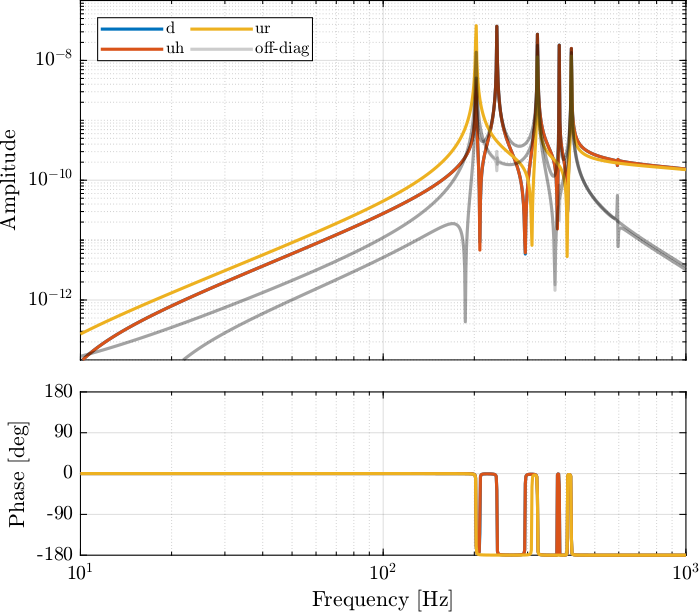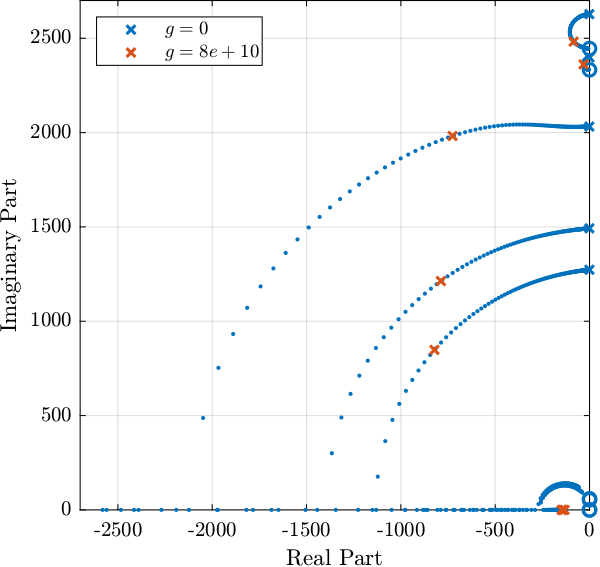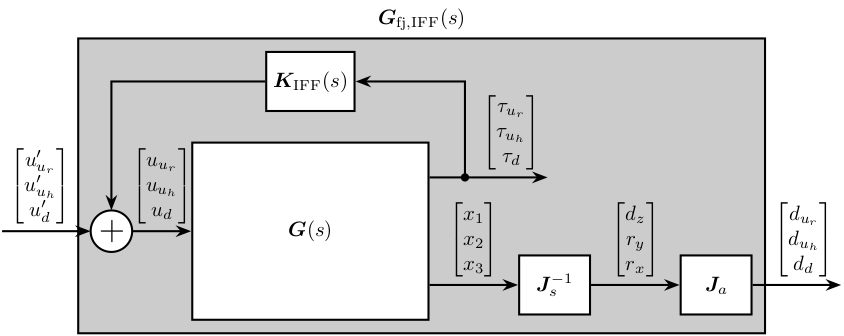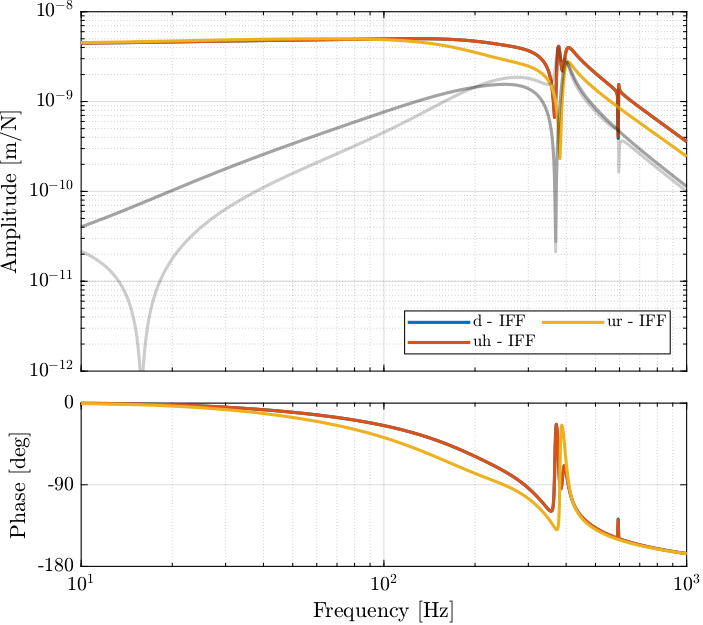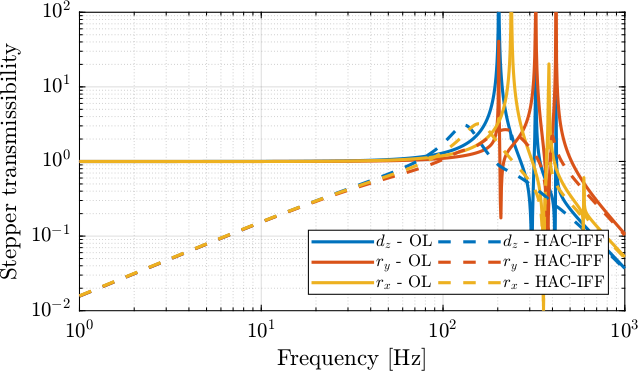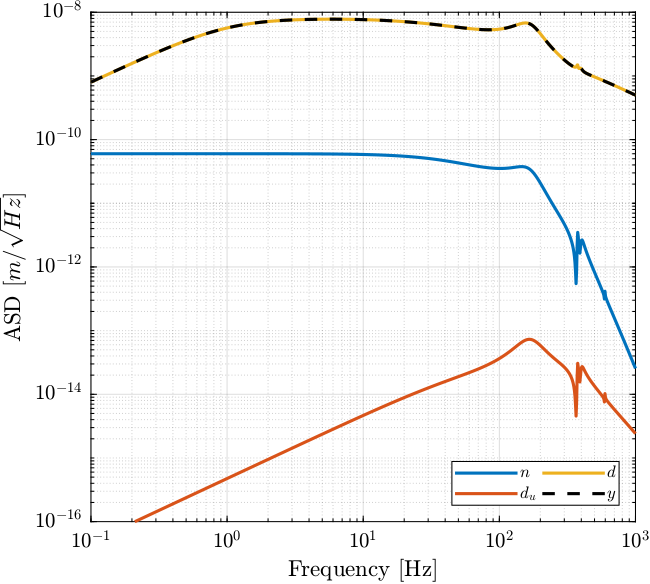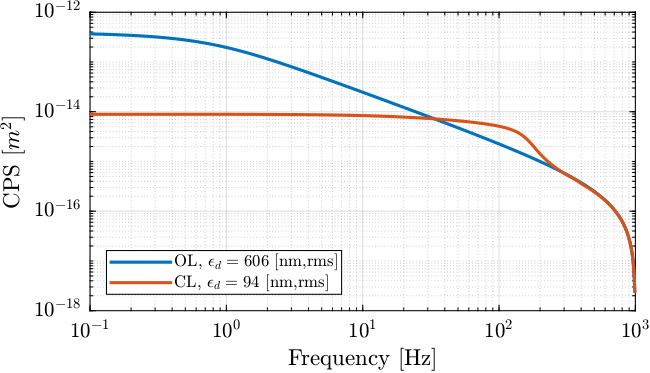100 KiB
ESRF Double Crystal Monochromator - Dynamical Multi-Body Model
- Introduction
- System Kinematics
- Introduction
- General description of the system architecture - Terminology
- Forward and Inverse Kinematics problems
- Bragg Angle
- Kinematics of "hall" Crystals
- Kinematics of "ring" Crystals
- Kinematics of the Metrology Frame
- Computing relative position between Crystals
- Summary - List of notations
- Save Kinematics
- Open Loop System Identification
- Open-Loop Noise Budgeting
- Active Damping Plant (Strain gauges)
- Active Damping Plant (Force Sensors)
- Feedback Control
- HAC-LAC (IFF) architecture
- Bibliography
This report is also available as a pdf.
Introduction ignore
In this document, a Simscape (.e.g. multi-body) model of the ESRF Double Crystal Monochromator (DCM) is presented and used to develop and optimize the control strategy.
It is structured as follow:
- Section sec:dcm_kinematics: the kinematics of the DCM is presented, and Jacobian matrices which are used to solve the inverse and forward kinematics are computed.
- Section sec:open_loop_identification: the system dynamics is identified in the absence of control.
- Section sec:dcm_noise_budget: an open-loop noise budget is performed.
- Section sec:active_damping_strain_gauges: it is studied whether if the strain gauges fixed to the piezoelectric actuators can be used to actively damp the plant.
- Section sec:active_damping_iff: piezoelectric force sensors are added in series with the piezoelectric actuators and are used to actively damp the plant using the Integral Force Feedback (IFF) control strategy.
- Section sec:hac_iff: the High Authority Control - Low Authority Control (HAC-LAC) strategy is tested on the Simscape model.
System Kinematics
<<sec:dcm_kinematics>>
Introduction ignore
In this section, the kinematics of the DCM is described. The elements (crystals, fast jacks, metrology frame, …) are all defined. The associated frames in which the motion of those elements are expressed will also be defined. Finally, the transformation necessary to compute the relative pose of the crystals from the metrology is computed.
General description of the system architecture - Terminology
In order to describe the motion of the different elements, reference frames are used.
One global frame is first defined with:
- the $x$ axis is aligned with the x-ray
- the $y$ axis aligned with the Bragg axis
- the $z$ axis is pointing up aligned with the gravity
The axis are shown in Figure fig:dcm_schematic_overview. The origin of this frame is usually taken at the intersection between the x-ray and the bragg axis.
The Bragg axis is therefore rotating around the $y$ axis. Two sets of two crystals are also rotating with the bragg axis. One set is positioned on the "hall" side (i.e toward $+y$) while the other set is positioned on the "ring" side (i.e. toward $-y$).
For each of these two sets, there is a "primary" crystal directly fixed to the bragg axis, and a "secondary" crystal fixed on top of three fastjacks. There are therefore 4 crystals in total for each Double Crystal Monochromator.
There is then a metrology frame that hold all the interferometers.
Several reference frame are used (displayed in Figure fig:dcm_schematic_overview for the "ring" crystals):
- $\{\mathcal{F}_{1r}\}$ and $\{\mathcal{F}_{1h}\}$: frames fixed to the bottom surface of first crystals with their origin at the intersection between the X-ray and the Bragg axis
- $\{\mathcal{F}_{2r}\}$ and $\{\mathcal{F}_{2h)}\}$: frames fixed to the top surface of second crystals. Their origin is at the crystal's center
- $\{\mathcal{F}_{mf}\}$: frame fixed to the center of the top part of the metrology frame
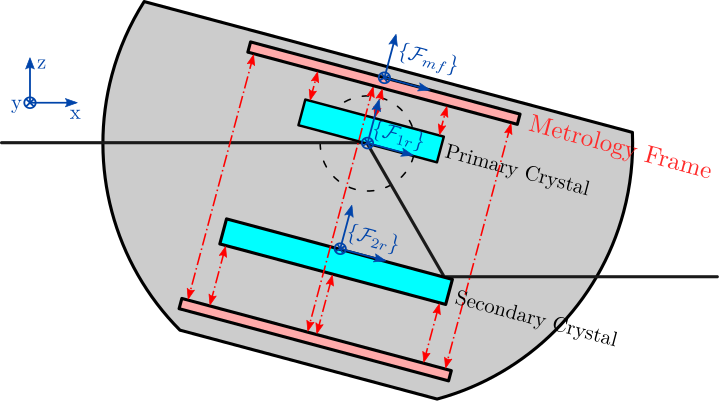
Here are the different letters used in the notations and there meaning:
r: "ring" (i.e. toward $-y$)h: "hall" (i.e. toward $+y$)u: "upstream" (i.e. towards $-x$)d: "downstream" (i.e. towards $+x$)c: "center" (i.e. centered at $x=0$)1: primary crystal2: secondary crystalmf: metrology frame
Forward and Inverse Kinematics problems
Let's consider one plane initially orthogonal to the $z$ direction (Figure fig:schematic_measurement_plane). The pose of the plane, expressed in a frame $\{\mathcal{F}\}$ with origin $\mathcal{O}$ is defined by:
- its vertical motion: $d_z$
- its rotation around the $y$ axis: $r_y$
- its rotation around the $x$ axis: $r_x$
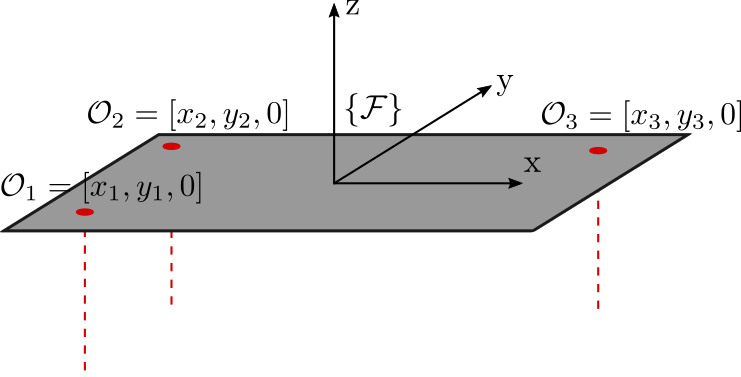
In order to measure the pose of the crystal, three interferometers are measuring the motion of the plane at three distinct positions $\mathcal{O}_1 = [x_1, y_1, 0]$, $\mathcal{O}_2 = [x_2, y_2, 0]$ and $\mathcal{O}_3 = [x_3, y_3, 0]$ (See Figure fig:schematic_measurement_plane). The interferometers can be pointed in the $z$ direction or in the opposite $z$ direction. The measured motion are noted $z_1$, $z_2$ and $z_3$.
The inverse kinematic problem consists of deriving the measured $[z_1, z_2, z_3]$ motions from the pose $[d_z, r_y, r_x]$ of the crystal. For small motion, this problem can be easily solved as follows:
\begin{equation} \boxed{ \begin{bmatrix} z_{1} \\ z_{2} \\ z_{3} \end{bmatrix} = \bm{J} \begin{bmatrix} d_{z} \\ r_{y} \\ r_{x} \end{bmatrix} } \end{equation}with $\bm{J}$ called the Jacobian matrix.
The Jacobian matrix can be computed as follows in the case where the interferometers are pointing toward positive $z$:
\begin{equation} \label{eq:jacobian_3dof_positive_z}
\boxed{
\bm{J} = \begin{bmatrix}
1 & -x_1 & y_1
1 & -x_2 & y_2
1 & -x_3 & y_3
\end{bmatrix} }
\end{equation}
and computed as follows if there are pointing torward negative $z$:
\begin{equation} \label{eq:jacobian_3dof_negative_z}
\boxed{
\bm{J} = \begin{bmatrix}
-1 & x_1 & -y_1
-1 & x_2 & -y_2
-1 & x_3 & -y_3
\end{bmatrix} }
\end{equation}
The forward kinematic problem is then solved by inverting the Jacobian matrix:
\begin{equation} \boxed{ \begin{bmatrix} d_{z} \\ r_{y} \\ r_{x} \end{bmatrix} = \bm{J}^{-1} \begin{bmatrix} z_{1} \\ z_{2} \\ z_{3} \end{bmatrix} } \end{equation}The same reasoning can be performed to convert the wanted motion of one plane to the motion of three vertical actuators fixed to the plane (tripod architecture).
Bragg Angle
<<sec:kinematics_bragg>> In order to have a fix exit, the following relation must be verified: \begin{equation} \label{eq:bragg_angle_formula} \boxed{d_z = \frac{d_{\text{off}}}{2 cos θ_b}}
\end{equation} with:
- $d_{\text{off}}$ the wanted offset between the incident x-ray and the output x-ray
- $\theta_b$ the bragg angle
- $d_z$ the corresponding distance between the first and second crystal
This relation is shown in Figure fig:jack_motion_bragg_angle for a wanted fix exit offset of 10mm.
Kinematics of "hall" Crystals
<<sec:kinematics_hall_crystal>>
Introduction ignore
There are two "hall" crystals, the primary one and the secondary one.
Interferometers - Primary "Hall" Crystal
Three interferometers fixed to the top metrology frame are pointed to the top surface (i.e. toward negative $z$) of the primary "hall" crystal. The measurements are performed along the $z$ direction.
The notations are:
- $\{\mathcal{F}_{1h}\}$ is the frame in which motion of the crystal are expressed
- $\mathcal{O}_{1h,ur}$ measurement point for the "upstream-ring" interferometer
- $\mathcal{O}_{1h,ch}$ measurement point for the "center-hall" interferometer
- $\mathcal{O}_{1h,dr}$ measurement point for the "downstream-ring" interferometer
The measured displacements by the interferometers are noted $[z_{1h,ur},\ z_{1h,ch},\ z_{1h,dr}]$.
The corresponding motion of the crystal expressed in the frame as shown in Figure fig:sensor_hall_crystal_points_primary are:
- $d_{1h,z}$ motion in the $z$ direction
- $r_{1h,y}$ rotation around the $y$ axis
- $r_{1h,x}$ rotation around the $x$ axis
\begin{tikzpicture}
% Crystal
\draw (-7.5/2, -3.5/2) rectangle (7.5/2, 3.5/2);
% Measurement Points
\node[branch] (a1) at (-3.6, -1.5){};
\node[branch] (a2) at ( 0, 1.5){};
\node[branch] (a3) at ( 3.6, -1.5){};
% Labels
\node[right] at (a1) {$\mathcal{O}_{1h,ur} = (-36, -15)$};
\node[right] at (a2) {$\mathcal{O}_{1h,ch} = ( 0, 15)$};
\node[left] at (a3) {$\mathcal{O}_{1h,dr} = ( 36, -15)$};
% Origin
\draw[->] (0, 0) node[] -- ++(1, 0) node[right]{$x$};
\draw[->] (0, 0) -- ++(0, 1) node[right]{$y$};
\draw[fill, color=black] (0, 0) circle (0.05);
\draw[color=black] (0, 0) circle (0.15);
\node[above right] at (0, 0){$z$};
\node[left] at (0,0) {$\{\mathcal{F}_{1h}\}$};
\end{tikzpicture}The inverse kinematics problem consists of deriving the measured displacement by the interferometer from the motion of the crystal (see Figure fig:schematic_sensor_jacobian_inverse_kinematics_hall_primary):
\begin{equation} \boxed{ \begin{bmatrix} z_{1h,ur} \\ z_{1h,ch} \\ z_{1h,dr} \end{bmatrix} = \bm{J}_{1h,s} \begin{bmatrix} d_{1h,z} \\ r_{1h,y} \\ r_{1h,x} \end{bmatrix} } \end{equation}\begin{tikzpicture}
% Blocs
\node[block] (Js) {$\bm{J}_{1h,s}$};
% Connections and labels
\draw[->] ($(Js.west)+(-1.5,0)$) node[above right]{$\begin{bmatrix} d_{1h,z} \\ r_{1h,y} \\ r_{1h,x} \end{bmatrix}$} -- (Js.west);
\draw[->] (Js.east) -- ++(1.5, 0) node[above left]{$\begin{bmatrix} z_{1h,ur} \\ z_{1h,ch} \\ z_{1h,dr} \end{bmatrix}$};
\end{tikzpicture}From the measurement coordinates in Figure fig:sensor_hall_crystal_points_primary and equation eqref:eq:jacobian_3dof_negative_z, the inverse kinematics the folowing Jacobian matrix is obtained:
\begin{equation} \boxed{\bm{J}_{1h,s} = \begin{bmatrix} -1 & -0.036 & 0.015 \\ -1 & 0 & -0.015 \\ -1 & 0.036 & 0.015 \end{bmatrix}} \end{equation}The forward kinematics problem (computing the crystal motion from the 3 interferometers) is solved by inverting the Jacobian matrix (see Figure fig:schematic_sensor_jacobian_forward_kinematics_hall_primary).
\begin{equation} \boxed{ \begin{bmatrix} d_{1h,z} \\ r_{1h,y} \\ r_{1h,x} \end{bmatrix} = \bm{J}_{1h,s}^{-1} \begin{bmatrix} z_{1h,ur} \\ z_{1h,ch} \\ z_{1h,dr} \end{bmatrix} } \end{equation}\begin{tikzpicture}
% Blocs
\node[block] (Js_inv) {$\bm{J}_{1h,s}^{-1}$};
% Connections and labels
\draw[->] ($(Js_inv.west)+(-1.5,0)$) node[above right]{$\begin{bmatrix} z_{1h,ur} \\ z_{1h,ch} \\ z_{1h,dr} \end{bmatrix}$} -- (Js_inv.west);
\draw[->] (Js_inv.east) -- ++(1.5, 0) node[above left]{$\begin{bmatrix} d_{1h,z} \\ r_{1h,y} \\ r_{1h,x} \end{bmatrix}$};
\end{tikzpicture}The obtained matrix is displayed in Table tab:inverse_jacobian_sensor_hall_primary.
| -0.25 | -0.5 | -0.25 |
| -13.89 | 0.0 | 13.89 |
| 16.67 | -33.33 | 16.67 |
Interferometers - Secondary "Hall" Crystal
Three interferometers are pointed to the bottom surface (i.e. toward positive $z$) of the secondary "hall" crystal.
The position of the measurement points are shown in Figure fig:sensor_hall_secondary_crystal_points as well as the origin where the motion of the crystal is computed.
The notations are:
- $\{\mathcal{F}_{2h}\}$ is the frame in which motion of the crystal are expressed
- $\mathcal{O}_{2h,ur}$ measurement point for the "upstream-ring" interferometer
- $\mathcal{O}_{2h,ch}$ measurement point for the "center-hall" interferometer
- $\mathcal{O}_{2h,dr}$ measurement point for the "downstream-ring" interferometer
The measured displacements by the interferometers are noted $[z_{2h,ur},\ z_{2h,ch},\ z_{2h,dr}]$.
The corresponding motion of the crystal expressed in the frame as shown in Figure fig:sensor_hall_secondary_crystal_points are:
- $d_{2h,z}$ motion in the $z$ direction
- $r_{2h,y}$ rotation around the $y$ axis
- $r_{2h,x}$ rotation around the $x$ axis
\begin{tikzpicture}
% Crystal
\draw (-15/2, -3.5/2) rectangle (15/2, 3.5/2);
% Measurement Points
\node[branch] (a1) at (-7, 1.5){};
\node[branch] (a2) at ( 0, -1.5){};
\node[branch] (a3) at ( 7, 1.5){};
% Labels
\node[right] at (a1) {$\mathcal{O}_{2h,ur} = (-70, -15)$};
\node[right] at (a2) {$\mathcal{O}_{2h,ch} = ( 0, 15)$};
\node[left] at (a3) {$\mathcal{O}_{2h,dr} = ( 70, -15)$};
% Origin
\draw[->] (0, 0) node[] -- ++(1, 0) node[below]{$x$};
\draw[->] (0, 0) -- ++(0, -1) node[right]{$y$};
\draw[fill, color=black] (0, 0) circle (0.05);
\draw[color=black] (0, 0) circle (0.15);
\draw[] (-0.1, 0.1) -- ( 0.1, -0.1);
\draw[] (-0.1,-0.1) -- ( 0.1, 0.1);
\node[below right] at (0,0) {$z$};
\node[left] at (0,0) {$\{\mathcal{F}_{2h}\}$};
\end{tikzpicture}The inverse kinematics consisting of deriving the interferometer measurements from the motion of the crystal (see Figure fig:schematic_sensor_jacobian_inverse_kinematics_hall_secondary):
\begin{equation} \boxed{ \begin{bmatrix} z_{2h,ur} \\ z_{2h,ch} \\ z_{2h,dr} \end{bmatrix} = \bm{J}_{2h,s} \begin{bmatrix} d_{2h,z} \\ r_{2h,y} \\ r_{2h,x} \end{bmatrix} } \end{equation}\begin{tikzpicture}
% Blocs
\node[block] (Js) {$\bm{J}_{2h,s}$};
% Connections and labels
\draw[->] ($(Js.west)+(-1.5,0)$) node[above right]{$\begin{bmatrix} d_{2h,z} \\ r_{2h,y} \\ r_{2h,x} \end{bmatrix}$} -- (Js.west);
\draw[->] (Js.east) -- ++(1.5, 0) node[above left]{$\begin{bmatrix} z_{2h,ur} \\ z_{2h,ch} \\ z_{2h,dr} \end{bmatrix}$};
\end{tikzpicture}From the measurement coordinates in Figure fig:sensor_hall_secondary_crystal_points and equation eqref:eq:jacobian_3dof_positive_z, the inverse kinematics the folowing Jacobian matrix is obtained:
\begin{equation} \boxed{\bm{J}_{2h,s} = \begin{bmatrix} 1 & 0.07 & -0.015 \\ 1 & 0 & 0.015 \\ 1 & -0.07 & -0.015 \end{bmatrix}} \end{equation}The forward kinematics is solved by inverting the Jacobian matrix (see Figure fig:schematic_sensor_jacobian_forward_kinematics_hall_secondary).
\begin{equation} \boxed{ \begin{bmatrix} d_{2h,z} \\ r_{2h,y} \\ r_{2h,x} \end{bmatrix} = \bm{J}_{2h,s}^{-1} \begin{bmatrix} z_{2h,ur} \\ z_{2h,ch} \\ z_{2h,dr} \end{bmatrix} } \end{equation}\begin{tikzpicture}
% Blocs
\node[block] (Js_inv) {$\bm{J}_{2h,s}^{-1}$};
% Connections and labels
\draw[->] ($(Js_inv.west)+(-1.5,0)$) node[above right]{$\begin{bmatrix} z_{2h,ur} \\ z_{2h,ch} \\ z_{2h,dr} \end{bmatrix}$} -- (Js_inv.west);
\draw[->] (Js_inv.east) -- ++(1.5, 0) node[above left]{$\begin{bmatrix} d_{2h,z} \\ r_{2h,y} \\ r_{2h,x} \end{bmatrix}$};
\end{tikzpicture}The results is shown in Table tab:inverse_jacobian_sensor_hall_secondary.
| 0.25 | 0.5 | 0.25 |
| 7.14 | 0.0 | -7.14 |
| -16.67 | 33.33 | -16.67 |
Piezo - hall Crystal
The locations of the actuators with respect with the center of the secondary "hall" crystal are shown in Figure fig:actuator_jacobian_hall_points.
Inverse Kinematics consist of deriving the corresponding z motion of the 3 actuators from the motion of the crystal expressed in $\{\mathcal{F}_{2h}\}$. As in the previous section, the motion of the secondary "hall" crystal is expressed by $[d_{2h,z},\ r_{2h,y},\ r_{2h,x}]$. The motion of the three fast jacks are expressed by $[d_{u_r},\ d_{u_h},\ d_{d}]$ are are corresponding to a motion along the $z$ axis toward positive values.
The inverse kinematics can therefore be solved as follows:
\begin{equation} \boxed{ \begin{bmatrix} d_{u_r} \\ d_{u_h} \\ d_{d} \end{bmatrix} = \bm{J}_{h,a} \begin{bmatrix} d_{2h,z} \\ r_{2h,y} \\ r_{2h,x} \end{bmatrix} } \end{equation}\begin{tikzpicture}
% Blocs
\node[block] (Ja) {$\bm{J}_{h,a}$};
% Connections and labels
\draw[->] ($(Ja.west)+(-1.5,0)$) node[above right]{$\begin{bmatrix} d_{2h,z} \\ r_{2h,y} \\ r_{2h,x} \end{bmatrix}$} -- (Ja.west);
\draw[->] (Ja.east) -- ++(1.5, 0) node[above left]{$\begin{bmatrix} d_{u_r} \\ d_{u_h} \\ d_d \end{bmatrix}$};
\end{tikzpicture}Based on the geometry in Figure fig:actuator_jacobian_hall_points, the following Jacobian matrix is obtained (see Eq. eqref:eq:jacobian_3dof_positive_z):
\begin{equation} \boxed{\bm{J}_{h,a} = \begin{bmatrix} 1 & 0.14 & -0.1525 \\ 1 & 0.14 & 0.0675 \\ 1 & -0.14 & -0.0425 \end{bmatrix}} \end{equation}The forward Kinematics is solved by inverting the Jacobian matrix:
\begin{equation} \boxed{ \begin{bmatrix} d_{2h,z} \\ r_{2h,y} \\ r_{2h,x} \end{bmatrix} = \bm{J}_{h,a}^{-1} \begin{bmatrix} d_{u_r} \\ d_{u_h} \\ d_{d} \end{bmatrix} } \end{equation}\begin{tikzpicture}
% Blocs
\node[block] (Ja_inv) {$\bm{J}_{h,a}^{-1}$};
% Connections and labels
\draw[->] ($(Ja_inv.west)+(-1.5,0)$) node[above right]{$\begin{bmatrix} d_{u_r} \\ d_{u_h} \\ d_d \end{bmatrix}$} -- (Ja_inv.west);
\draw[->] (Ja_inv.east) -- ++(1.5, 0) node[above left]{$\begin{bmatrix} d_{2h,z} \\ r_{2h,y} \\ r_{2h,x} \end{bmatrix}$};
\end{tikzpicture}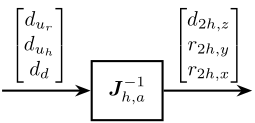 The obtained inverse Jacobian matrix is shown in Table tab:inverse_jacobian_actuator_hall.
The obtained inverse Jacobian matrix is shown in Table tab:inverse_jacobian_actuator_hall.
| 0.0568 | 0.4432 | 0.5 |
| 1.7857 | 1.7857 | -3.5714 |
| -4.5455 | 4.5455 | 0.0 |
Kinematics of "ring" Crystals
<<sec:kinematics_ring_crystal>>
Introduction ignore
The same reasoning is now done for the "ring" crystals.
Interferometers - ring primary Crystal
Three interferometers fixed to the top metrology frame are pointed to the top surface (i.e. toward negative $z$) of the primary "hall" crystal. The measurements are perform along the $z$ direction.
The notations are:
- $\{\mathcal{F}_{1r}\}$ is the frame in which motion of the crystal are expressed
- $\mathcal{O}_{1r,uh}$ measurement point for the "upstream-hall" interferometer
- $\mathcal{O}_{1r,cr}$ measurement point for the "center-ring" interferometer
- $\mathcal{O}_{1r,dh}$ measurement point for the "downstream-hall" interferometer
The measured displacements by the interferometers are noted $[z_{1r,ur},\ z_{1r,ch},\ z_{1r,dr}]$.
The corresponding motion of the crystal expressed in the frame as shown in Figure fig:sensor_hall_crystal_points_primary are:
- $d_{1r,z}$ motion in the $z$ direction
- $r_{1r,y}$ rotation around the $y$ axis
- $r_{1r,x}$ rotation around the $x$ axis
\begin{tikzpicture}
% Crystal
\draw (-7.5/2, -3.5/2) rectangle (7.5/2, 3.5/2);
% Measurement Points
\node[branch] (a1) at (-3.6, 1.5){};
\node[branch] (a2) at ( 0, -1.5){};
\node[branch] (a3) at ( 3.6, 1.5){};
% Labels
\node[right] at (a1) {$\mathcal{O}_{1r,uh} = (-36, 15)$};
\node[right] at (a2) {$\mathcal{O}_{1r,cr} = ( 0, -15)$};
\node[left] at (a3) {$\mathcal{O}_{1r,dh} = ( 36, 15)$};
% Origin
\draw[->] (0, 0) node[] -- ++(1, 0) node[right]{$x$};
\draw[->] (0, 0) -- ++(0, 1) node[right]{$y$};
\draw[fill, color=black] (0, 0) circle (0.05);
\draw[color=black] (0, 0) circle (0.15);
\node[above right] at (0, 0){$z$};
\node[left] at (0,0) {$\{\mathcal{F}_{1r}\}$};
\end{tikzpicture}The inverse kinematics consisting of deriving the interferometer measurements from the motion of the crystal (see Figure fig:schematic_sensor_jacobian_inverse_kinematics_ring_primary):
\begin{equation} \boxed{ \begin{bmatrix} z_{1r,ur} \\ z_{1r,ch} \\ z_{1r,dr} \end{bmatrix} = \bm{J}_{1r,s} \begin{bmatrix} d_{1r,z} \\ r_{1r,y} \\ r_{1r,x} \end{bmatrix} } \end{equation}\begin{tikzpicture}
% Blocs
\node[block] (Js) {$\bm{J}_{1r,s}$};
% Connections and labels
\draw[->] ($(Js.west)+(-1.5,0)$) node[above right]{$\begin{bmatrix} d_{1r,z} \\ r_{1r,y} \\ r_{1r,x} \end{bmatrix}$} -- (Js.west);
\draw[->] (Js.east) -- ++(1.5, 0) node[above left]{$\begin{bmatrix} z_{1r,ur} \\ z_{1r,ch} \\ z_{1r,dr} \end{bmatrix}$};
\end{tikzpicture}From the measurement coordinates in Figure fig:sensor_ring_crystal_points_primary and equation eqref:eq:jacobian_3dof_negative_z, the inverse kinematics the folowing Jacobian matrix is obtained:
\begin{equation} \boxed{\bm{J}_{1r,s} = \begin{bmatrix} -1 & -0.036 & -0.015 \\ -1 & 0 & 0.015 \\ -1 & 0.036 & -0.015 \end{bmatrix}} \end{equation}The forward kinematics is solved by inverting the Jacobian matrix (see Figure fig:schematic_sensor_jacobian_forward_kinematics_ring_primary).
\begin{equation} \boxed{ \begin{bmatrix} d_{1r,z} \\ r_{1r,y} \\ r_{1r,x} \end{bmatrix} = \bm{J}_{1r,s}^{-1} \begin{bmatrix} z_{1r,ur} \\ z_{1r,ch} \\ z_{1r,dr} \end{bmatrix} } \end{equation}\begin{tikzpicture}
% Blocs
\node[block] (Js_inv) {$\bm{J}_{1r,s}^{-1}$};
% Connections and labels
\draw[->] ($(Js_inv.west)+(-1.5,0)$) node[above right]{$\begin{bmatrix} z_{1r,ur} \\ z_{1r,ch} \\ z_{1r,dr} \end{bmatrix}$} -- (Js_inv.west);
\draw[->] (Js_inv.east) -- ++(1.5, 0) node[above left]{$\begin{bmatrix} d_{1r,z} \\ r_{1r,y} \\ r_{1r,x} \end{bmatrix}$};
\end{tikzpicture}The obtained inverse Jacobian matrix is shown in Table tab:inverse_jacobian_sensor_ring_primary.
| -0.25 | -0.5 | -0.25 |
| -13.89 | 0.0 | 13.89 |
| -16.67 | 33.33 | -16.67 |
Interferometers - ring secondary Crystal
Three interferometers are pointed to the bottom surface (i.e. toward positive $z$) of the secondary "ring" crystal.
The position of the measurement points are shown in Figure fig:sensor_ring_secondary_crystal_points as well as the origin where the motion of the crystal is computed.
The notations are:
- $\{\mathcal{F}_{2r}\}$ is the frame in which motion of the crystal are expressed
- $\mathcal{O}_{2r,uh}$ measurement point for the "upstream-hall" interferometer
- $\mathcal{O}_{2r,cr}$ measurement point for the "center-ring" interferometer
- $\mathcal{O}_{2r,dh}$ measurement point for the "downstream-hall" interferometer
The measured displacements by the interferometers are noted $[z_{2r,ur},\ z_{2r,ch},\ z_{2r,dr}]$.
The corresponding motion of the crystal expressed in the frame as shown in Figure fig:sensor_hall_secondary_crystal_points are:
- $d_{2r,z}$ motion in the $z$ direction
- $r_{2r,y}$ rotation around the $y$ axis
- $r_{2r,x}$ rotation around the $x$ axis
The position of the measurement points are shown in Figure fig:sensor_ring_secondary_crystal_points as well as the origin where the motion of the crystal is computed.
\begin{tikzpicture}
% Crystal
\draw (-15/2, -3.5/2) rectangle (15/2, 3.5/2);
% Measurement Points
\node[branch] (a1) at (-7, -1.5){};
\node[branch] (a2) at ( 0, 1.5){};
\node[branch] (a3) at ( 7, -1.5){};
% Labels
\node[right] at (a1) {$\mathcal{O}_{2r,uh} = (-70, 15)$};
\node[right] at (a2) {$\mathcal{O}_{2r,cr} = ( 0, -15)$};
\node[left] at (a3) {$\mathcal{O}_{2r,dh} = ( 70, 15)$};
% Origin
\draw[->] (0, 0) node[] -- ++(1, 0) node[below]{$x$};
\draw[->] (0, 0) -- ++(0, -1) node[right]{$y$};
\draw[fill, color=black] (0, 0) circle (0.05);
\draw[color=black] (0, 0) circle (0.15);
\draw[] (-0.1, 0.1) -- ( 0.1, -0.1);
\draw[] (-0.1,-0.1) -- ( 0.1, 0.1);
\node[below right] at (0,0) {$z$};
\node[left] at (0,0) {$\{\mathcal{F}_{2r}\}$};
\end{tikzpicture}The inverse kinematics consisting of deriving the interferometer measurements from the motion of the crystal (see Figure fig:schematic_sensor_jacobian_inverse_kinematics_ring_secondary):
\begin{equation} \boxed{ \begin{bmatrix} z_{2r,uh} \\ z_{2r,cr} \\ z_{2r,dh} \end{bmatrix} = \bm{J}_{2r,s} \begin{bmatrix} d_{2r,z} \\ r_{2r,y} \\ r_{2r,x} \end{bmatrix} } \end{equation}\begin{tikzpicture}
% Blocs
\node[block] (Js) {$\bm{J}_{2r,s}$};
% Connections and labels
\draw[->] ($(Js.west)+(-1.5,0)$) node[above right]{$\begin{bmatrix} d_{2r,z} \\ r_{2r,y} \\ r_{2r,x} \end{bmatrix}$} -- (Js.west);
\draw[->] (Js.east) -- ++(1.5, 0) node[above left]{$\begin{bmatrix} z_{2r,uh} \\ z_{2r,cr} \\ z_{2r,dh} \end{bmatrix}$};
\end{tikzpicture}From the measurement coordinates in Figure fig:sensor_ring_secondary_crystal_points and equation eqref:eq:jacobian_3dof_positive_z, the inverse kinematics the folowing Jacobian matrix is obtained:
\begin{equation} \boxed{\bm{J}_{2r,s} = \begin{bmatrix} 1 & 0.07 & 0.015 \\ 1 & 0 & -0.015 \\ 1 & -0.07 & 0.015 \end{bmatrix}} \end{equation}The forward kinematics is solved by inverting the Jacobian matrix (see Figure fig:schematic_sensor_jacobian_forward_kinematics_ring_secondary).
\begin{equation} \boxed{ \begin{bmatrix} d_{2r,z} \\ r_{2r,y} \\ r_{2r,x} \end{bmatrix} = \bm{J}_{2r,s}^{-1} \begin{bmatrix} z_{2r,uh} \\ z_{2r,cr} \\ z_{2r,dh} \end{bmatrix} } \end{equation}\begin{tikzpicture}
% Blocs
\node[block] (Js_inv) {$\bm{J}_{s,r}^{-1}$};
% Connections and labels
\draw[->] ($(Js_inv.west)+(-1.5,0)$) node[above right]{$\begin{bmatrix} z_{2r,uh} \\ z_{2r,cr} \\ z_{2r,dh} \end{bmatrix}$} -- (Js_inv.west);
\draw[->] (Js_inv.east) -- ++(1.5, 0) node[above left]{$\begin{bmatrix} d_{2r,z} \\ r_{2r,y} \\ r_{2r,x} \end{bmatrix}$};
\end{tikzpicture}The obtained inverse Jacobian matrix is shown in Table tab:inverse_jacobian_sensor_ring_secondary.
| 0.25 | 0.5 | 0.25 |
| 7.14 | 0.0 | -7.14 |
| 16.67 | -33.33 | 16.67 |
Piezo - ring Crystal
The location of the actuators with respect with the center of the secondary "ring" crystal are shown in Figure fig:actuator_jacobian_ring_points.
Inverse Kinematics consist of deriving the corresponding z motion of the 3 actuators from the motion of the crystal expressed in $\{\mathcal{F}_{2r}\}$. As in the previous section, the motion of the secondary "ring" crystal is expressed by $[d_{2r,z},\ r_{2r,y},\ r_{2r,x}]$. The motion of the three fast jacks are expressed by $[d_{u_r},\ d_{u_h},\ d_{d}]$ are are corresponding to a motion along the $z$ axis toward positive values.
The inverse kinematics can therefore be solved as follows:
\begin{equation} \boxed{ \begin{bmatrix} d_{u_r} \\ d_{u_h} \\ d_{d} \end{bmatrix} = \bm{J}_{h,a} \begin{bmatrix} d_{2r,z} \\ r_{2r,y} \\ r_{2r,x} \end{bmatrix} } \end{equation}\begin{tikzpicture}
% Blocs
\node[block] (Ja) {$\bm{J}_{r,a}$};
% Connections and labels
\draw[->] ($(Ja.west)+(-1.5,0)$) node[above right]{$\begin{bmatrix} d_{2r,z} \\ r_{2r,y} \\ r_{2r,x} \end{bmatrix}$} -- (Ja.west);
\draw[->] (Ja.east) -- ++(1.5, 0) node[above left]{$\begin{bmatrix} d_{u_r} \\ d_{u_h} \\ d_d \end{bmatrix}$};
\end{tikzpicture}Based on the geometry in Figure fig:actuator_jacobian_ring_points, we obtain (see Eq. eqref:eq:jacobian_3dof_positive_z):
\begin{equation} \boxed{\bm{J}_{r,a} = \begin{bmatrix} 1 & 0.14 & -0.0675 \\ 1 & 0.14 & 0.1525 \\ 1 & -0.14 & 0.0425 \end{bmatrix}} \end{equation}The forward Kinematics is solved by inverting the Jacobian matrix:
\begin{equation} \boxed{ \begin{bmatrix} d_{2r,z} \\ r_{2r,y} \\ r_{2r,x} \end{bmatrix} = \bm{J}_{r,a}^{-1} \begin{bmatrix} d_{u_r} \\ d_{u_h} \\ d_{d} \end{bmatrix} } \end{equation}\begin{tikzpicture}
% Blocs
\node[block] (Ja_inv) {$\bm{J}_{r,a}^{-1}$};
% Connections and labels
\draw[->] ($(Ja_inv.west)+(-1.5,0)$) node[above right]{$\begin{bmatrix} d_{u_r} \\ d_{u_h} \\ d_d \end{bmatrix}$} -- (Ja_inv.west);
\draw[->] (Ja_inv.east) -- ++(1.5, 0) node[above left]{$\begin{bmatrix} d_{2r,z} \\ r_{2r,y} \\ r_{2r,x} \end{bmatrix}$};
\end{tikzpicture}The obtained inverse Jacobian matrix is shown in Table tab:inverse_jacobian_actuator_ring_secondary.
| 0.4432 | 0.0568 | 0.5 |
| 1.7857 | 1.7857 | -3.5714 |
| -4.5455 | 4.5455 | 0.0 |
Kinematics of the Metrology Frame
<<sec:kinematics_metrology_frame>>
Three interferometers (aligned with the $z$ axis) are used to measure the relative motion between the bottom part and the top part of the metrology frame.
The location of the three interferometers are shown in Figure fig:jacobian_metrology_frame.
The measured displacements by the interferometers are are noted $[z_{mf,u},\ z_{mf,dh},\ z_{mf,dr}]$.
We here suppose that the bottom part of the metrology frame is fixed and only the top part is moving. The motion of the metrology top part expressed in the frame as shown in Figure fig:jacobian_metrology_frame are:
- $d_{mf,z}$ motion in the $z$ direction
- $r_{mf,y}$ rotation around the $y$ axis
- $r_{mf,x}$ rotation around the $x$ axis
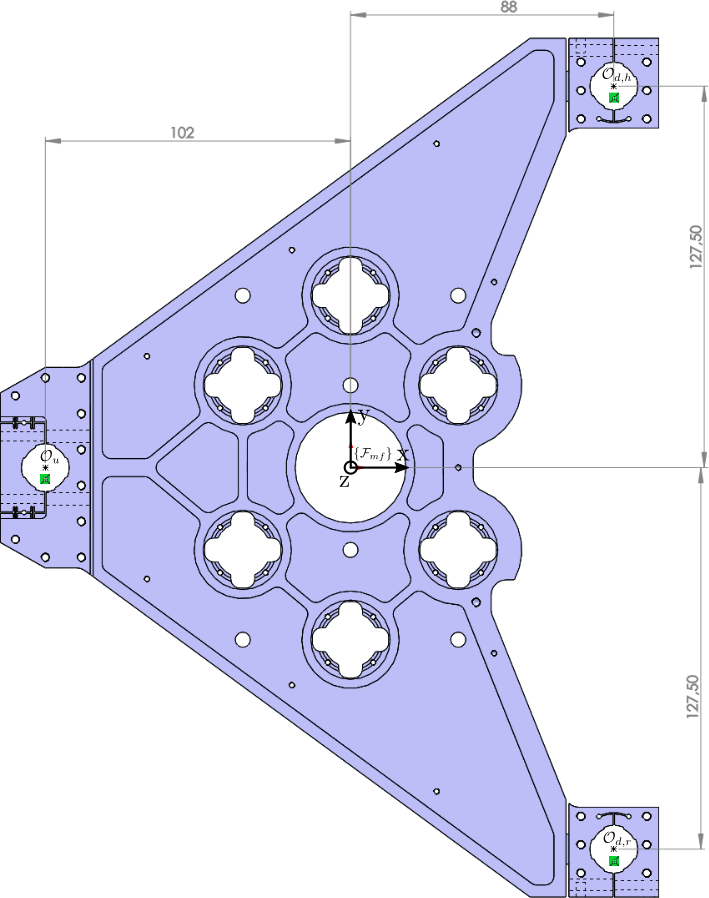
The inverse kinematics consisting of deriving the interferometer measurements from the motion of the metrology top part:
\begin{equation} \boxed{ \begin{bmatrix} z_{mf,u} \\ z_{mf,dh} \\ z_{mf,dr} \end{bmatrix} = \bm{J}_{mf,s} \begin{bmatrix} d_{mf,z} \\ r_{mf,y} \\ r_{mf,x} \end{bmatrix} } \end{equation}From the coordinates in Figure fig:jacobian_metrology_frame and the equation eqref:eq:jacobian_3dof_positive_z, the following Jacobian matrix is obtained:
\begin{equation} \boxed{\bm{J}_{mf,r} = \begin{bmatrix} 1 & 0.102 & 0 \\ 1 & -0.088 & 0.1275 \\ 1 & -0.088 & -0.1275 \end{bmatrix}} \end{equation}The forward kinematics is solved by inverting the Jacobian matrix:
\begin{equation} \boxed{ \begin{bmatrix} d_{mf,z} \\ r_{mf,y} \\ r_{mf,x} \end{bmatrix} = \bm{J}_{mf,s}^{-1} \begin{bmatrix} z_{mf,u} \\ z_{mf,dh} \\ z_{mf,dr} \end{bmatrix} } \end{equation}The obtained inverse Jacobian matrix is shown in Table tab:inverse_jacobian_sensor_metrology_frame.
| 0.463 | 0.268 | 0.268 |
| 5.263 | -2.632 | -2.632 |
| 0.0 | 3.922 | -3.922 |
Computing relative position between Crystals
In the previous sections, the motion of the individual crystals have been computed.
We wish to express the relative pose of the primary and secondary crystals $[d_{h,z},\ r_{h,y},\ r_{h,x}]$ or $[d_{r,z},\ r_{r,y},\ r_{r,x}]$.
The sign conventions for the relative crystal pose are:
- An increase of $d_{h,z}$ means the two crystals are further apart
- An increase of $r_{h,}$ means that the second crystals experiences a rotation around $y$ with respect to the primary crystal
- An increase of $r_{h,x}$ means that the second crystals experiences a rotation around $x$ with respect to the primary crystal
We therefore have the following relation (same for "hall" and "ring" crystals):
\begin{equation} \boxed{ \begin{bmatrix} d_{h,z} \\ r_{h,y} \\ r_{h,x} \end{bmatrix} = \begin{bmatrix} d_{2h,z} \\ r_{2h,y} \\ r_{2h,x} \end{bmatrix} - \begin{bmatrix} d_{1h,z} \\ r_{1h,y} \\ r_{1h,x} \end{bmatrix} - \begin{bmatrix} d_{mf,z} \\ r_{mf,y} \\ r_{mf,x} \end{bmatrix} } \end{equation}The relative pose can be expressed as a function of the interferometers using the Jacobian matrices for the "hall" crystals:
\begin{equation} \boxed{ \begin{bmatrix} d_{h,z} \\ r_{h,y} \\ r_{h,x} \end{bmatrix} = \bm{J}_{2h,s}^{-1} \begin{bmatrix} z_{2h,ur} \\ z_{2h,ch} \\ z_{2h,dr} \end{bmatrix} - \bm{J}_{1h,s}^{-1} \begin{bmatrix} z_{1h,ur} \\ z_{1h,ch} \\ z_{1h,dr} \end{bmatrix} - \bm{J}_{mf,s}^{-1} \begin{bmatrix} z_{mf,u} \\ z_{mf,dh} \\ z_{mf,dr} \end{bmatrix} } \end{equation}As well as for the "ring" crystals:
\begin{equation} \boxed{ \begin{bmatrix} d_{r,z} \\ r_{r,y} \\ r_{r,x} \end{bmatrix} = \bm{J}_{2r,s}^{-1} \begin{bmatrix} z_{2r,ur} \\ z_{2r,cr} \\ z_{2r,dr} \end{bmatrix} - \bm{J}_{1r,s}^{-1} \begin{bmatrix} z_{1r,ur} \\ z_{1r,cr} \\ z_{1r,dr} \end{bmatrix} - \bm{J}_{mf,s}^{-1} \begin{bmatrix} z_{mf,u} \\ z_{mf,dr} \\ z_{mf,dr} \end{bmatrix} } \end{equation}Summary - List of notations
There are 5 Jacobian matrices that are used to convert the 15 interferometers to the relative pose between the primary and secondary crystals as well as 2 Jacobian matrices for the actuators. All Jacobian matrices are summarized in Table tab:jacobian_matrices.
| Notation | Variable | Description |
|---|---|---|
| $\bm{J}_{1h,s}$ | J_1h_s |
Converts interferometers to the first "hall" crystal pose |
| $\bm{J}_{2h,s}$ | J_2h_s |
Converts interferometers to the second "hall" crystal pose |
| $\bm{J}_{1r,s}$ | J_1r_s |
Converts interferometers to the first "ring" crystal pose |
| $\bm{J}_{2r,s}$ | J_2r_s |
Converts interferometers to the second "ring" crystal pose |
| $\bm{J}_{mf,s}$ | J_mf_s |
Converts interferometers to the first "hall" crystal pose |
| $\bm{J}_{h,a}$ | J_h_a |
Converts Fastjack motion to the second "hall" crystal pose |
| $\bm{J}_{r,a}$ | J_r_a |
Converts Fastjack motion to the second "ring" crystal pose |
The 15 interferometer measurements are summarized in Table tab:interferometer_list.
| Notation | Variable | Interferometer |
|---|---|---|
| $z_{1h,ur}$ | z_1h_ur |
First "Hall" Crystal, "upstream-ring" |
| $z_{1h,ch}$ | z_1h_ch |
First "Hall" Crystal, "center-hall" |
| $z_{1h,dr}$ | z_1h_dr |
First "Hall" Crystal, "downstream-ring" |
| $z_{2h,ur}$ | z_2h_ur |
Second "Hall" Crystal, "upstream-ring" |
| $z_{2h,ch}$ | z_2h_ch |
Second "Hall" Crystal, "center-hall" |
| $z_{2h,dr}$ | z_2h_dr |
Second "Hall" Crystal, "downstream-ring" |
| $z_{1r,uh}$ | z_1r_uh |
First "Hall" Crystal, "upstream-hall" |
| $z_{1r,cr}$ | z_1r_cr |
First "Hall" Crystal, "center-ring" |
| $z_{1r,dh}$ | z_1r_dh |
First "Hall" Crystal, "downstream-hall" |
| $z_{2r,uh}$ | z_2r_uh |
Second "Hall" Crystal, "upstream-hall" |
| $z_{2r,cr}$ | z_2r_cr |
Second "Hall" Crystal, "center-ring" |
| $z_{2r,dh}$ | z_2r_dh |
Second "Hall" Crystal, "downstream-hall" |
| $z_{mf,u}$ | z_mf_u |
Metrology Frame, "upstream" |
| $z_{mf,dh}$ | z_mf_dh |
Metrology Frame, "downstream-hall" |
| $z_{mf,dr}$ | z_mf_dr |
Metrology Frame, "downstream-ring" |
From the 15 interferometers, several crystal pose are computed. They are summarized in Table tab:crystal_pose_list.
| Notation | Variable | Description |
|---|---|---|
| $d_{1h,z}$ | d_1h_z |
First "Hall" Crystal, z-translation |
| $r_{1h,y}$ | r_1h_y |
First "Hall" Crystal, y-rotation |
| $r_{1h,x}$ | r_1h_x |
First "Hall" Crystal, x-rotation |
| $d_{2h,z}$ | d_2h_z |
Second "Hall" Crystal, z-translation |
| $r_{2h,y}$ | r_2h_y |
Second "Hall" Crystal, y-rotation |
| $r_{2h,x}$ | r_2h_x |
Second "Hall" Crystal, x-rotation |
| $d_{1r,z}$ | d_1r_z |
First "Ring" Crystal, z-translation |
| $r_{1r,y}$ | r_1r_y |
First "Ring" Crystal, y-rotation |
| $r_{1r,x}$ | r_1r_x |
First "Ring" Crystal, x-rotation |
| $d_{2r,z}$ | d_2r_z |
Second "Ring" Crystal, z-translation |
| $r_{2r,y}$ | r_2r_y |
Second "Ring" Crystal, y-rotation |
| $r_{2r,x}$ | r_2r_x |
Second "Ring" Crystal, x-rotation |
| $d_{mf,z}$ | d_mf_z |
Metrology Frame, z-translation (top relative to bottom) |
| $r_{mf,y}$ | r_mf_y |
Metrology Frame, y-rotation (top relative to bottom) |
| $r_{mf,x}$ | r_mf_x |
Metrology Frame, x-rotation (top relative to bottom) |
And finally, the relative pose between the first and second crystals are defined in Table tab:crystal_relative_pose_list.
| Notation | Variable | Description |
|---|---|---|
| $d_{h,z}$ | d_h_z |
Relative distance between the "hall" crystals |
| $r_{h,y}$ | r_h_y |
Relative y-rotation of the 2nd "hall" crystal w.r.t. the primary |
| $r_{h,x}$ | r_h_x |
Relative x-rotation of the 2nd "hall" crystal w.r.t. the primary |
| $d_{r,z}$ | d_r_z |
Relative distance between the "ring" crystals |
| $r_{r,y}$ | r_r_y |
Relative y-rotation of the 2nd "ring" crystal w.r.t. the primary |
| $r_{r,x}$ | r_r_x |
Relative x-rotation of the 2nd "ring" crystal w.r.t. the primary |
Save Kinematics
All the Jacobian matrix are exported so that there can be easily imported for computation purposes.
save('mat/dcm_kinematics.mat', 'J_1h_s', 'J_1r_s', 'J_2h_s', 'J_2r_s', 'J_mf_s', 'J_h_a', 'J_r_a')Open Loop System Identification
<<sec:open_loop_identification>>
Introduction ignore
Identification
Let's considered the system $\bm{G}(s)$ with:
- 3 inputs: force applied to the 3 fast jacks
- 3 outputs: measured displacement by the 3 interferometers pointing at the ring second crystal
It is schematically shown in Figure fig:schematic_system_inputs_outputs.
\begin{tikzpicture}
% Blocs
\node[block] (G) {$\bm{G}(s)$};
% Connections and labels
\draw[->] ($(G.west)+(-1.5,0)$) node[above right]{$\begin{bmatrix} u_{u_r} \\ u_{u_h} \\ u_d \end{bmatrix}$} -- (G.west);
\draw[->] (G.east) -- ++(1.5, 0) node[above left]{$\begin{bmatrix} x_1 \\ x_2 \\ x_3 \end{bmatrix}$};
\end{tikzpicture}The system is identified from the Simscape model.
%% Input/Output definition
clear io; io_i = 1;
%% Inputs
% Control Input {3x1} [N]
io(io_i) = linio([mdl, '/control_system'], 1, 'openinput'); io_i = io_i + 1;
%% Outputs
% Interferometers {3x1} [m]
io(io_i) = linio([mdl, '/DCM'], 1, 'openoutput'); io_i = io_i + 1;%% Extraction of the dynamics
G = linearize(mdl, io);size(G)size(G) State-space model with 3 outputs, 3 inputs, and 24 states.
Plant in the frame of the fastjacks
load('dcm_kinematics.mat');Using the forward and inverse kinematics, we can computed the dynamics from piezo forces to axial motion of the 3 fastjacks (see Figure fig:schematic_jacobian_frame_fastjack).
\begin{tikzpicture}
% Blocs
\node[block] (G) {$\bm{G}(s)$};
\node[block, right=1.5 of G] (Js) {$\bm{J}_{s}^{-1}$};
\node[block, right=1.5 of Js] (Ja) {$\bm{J}_{a}$};
% Connections and labels
\draw[->] ($(G.west)+(-1.5,0)$) node[above right]{$\begin{bmatrix} u_{u_r} \\ u_{u_h} \\ u_d \end{bmatrix}$} -- (G.west);
\draw[->] (G.east) -- node[midway, above]{$\begin{bmatrix} x_1 \\ x_2 \\ x_3 \end{bmatrix}$} (Js.west);
\draw[->] (Js.east) -- node[midway, above]{$\begin{bmatrix} d_z \\ r_y \\ r_x \end{bmatrix}$} (Ja.west);
\draw[->] (Ja.east) -- ++(1.5, 0) node[above left]{$\begin{bmatrix} d_{u_r} \\ d_{u_h} \\ d_{d} \end{bmatrix}$};
\begin{scope}[on background layer]
\node[fit={(G.south west) ($(Ja.east)+(0, 1.4)$)}, fill=black!20!white, draw, inner sep=6pt] (system) {};
\node[above] at (system.north) {$\bm{G}_{\text{fj}}(s)$};
\end{scope}
\end{tikzpicture}%% Compute the system in the frame of the fastjacks
G_pz = J_a_h*inv(J_2h_s)*G;The DC gain of the new system shows that the system is well decoupled at low frequency.
dcgain(G_pz)| 4.4407e-09 | 2.7656e-12 | 1.0132e-12 |
| 2.7656e-12 | 4.4407e-09 | 1.0132e-12 |
| 1.0109e-12 | 1.0109e-12 | 4.4424e-09 |
The bode plot of $\bm{G}_{\text{fj}}(s)$ is shown in Figure fig:bode_plot_plant_fj.
G_pz = diag(1./diag(dcgain(G_pz)))*G_pz;Computing the system in the frame of the fastjack gives good decoupling at low frequency (until the first resonance of the system).
Plant in the frame of the crystal
\begin{tikzpicture}
% Blocs
\node[block] (G) {$\bm{G}(s)$};
\node[block, left=1.5 of G] (Ja) {$\bm{J}_{a}^{-T}$};
\node[block, right=1.5 of G] (Js) {$\bm{J}_{s}^{-1}$};
% Connections and labels
\draw[->] ($(Ja.west)+(-1.5,0)$) node[above right]{$\begin{bmatrix} \mathcal{F}_{z} \\ \mathcal{M}_{y} \\ \mathcal{M}_{x} \end{bmatrix}$} -- (Ja.west);
\draw[->] (Ja.east) -- node[midway, above]{$\begin{bmatrix} u_{u_r} \\ u_{u_h} \\ u_d \end{bmatrix}$} (G.west);
\draw[->] (G.east) -- node[midway, above]{$\begin{bmatrix} x_1 \\ x_2 \\ x_3 \end{bmatrix}$} (Js.west);
\draw[->] (Js.east) -- ++(1.5, 0) node[above left]{$\begin{bmatrix} d_z \\ r_y \\ r_x \end{bmatrix}$};
\begin{scope}[on background layer]
\node[fit={(Ja.south west) ($(Js.east)+(0, 1.4)$)}, fill=black!20!white, draw, inner sep=6pt] (system) {};
\node[above] at (system.north) {$\bm{G}_{\text{cr}}(s)$};
\end{scope}
\end{tikzpicture}G_mr = inv(J_s_r)*G*inv(J_a_r');dcgain(G_mr)| 1.9978e-09 | 3.9657e-09 | 7.7944e-09 |
| 3.9656e-09 | 8.4979e-08 | -1.5135e-17 |
| 7.7944e-09 | -3.9252e-17 | 1.834e-07 |
This results in a coupled system. The main reason is that, as we map forces to the center of the ring crystal and not at the center of mass/stiffness of the moving part, vertical forces will induce rotation and torques will induce vertical motion.
Open-Loop Noise Budgeting
<<sec:dcm_noise_budget>>
Introduction ignore
\begin{tikzpicture}
% Blocs
\node[block] (G) {$G(s)$};
\node[addb, left= of G] (adddu) {};
\node[block, left= of adddu] (K) {$K(s)$};
\node[addb={+}{}{}{}{-}, left= of K] (subL) {};
\node[addb, right= of G] (addd) {};
\node[addb, below right=0.8 and 0.6 of addd] (adddn) {};
% Connections and labels
\draw[->] (subL.east) -- (K.west);
\draw[->] (K.east) -- (adddu.west);
\draw[->] (adddu.east) -- (G.west);
\draw[->] (G.east) -- (addd.west);
\draw[->] (addd-|adddn)node[branch]{}node[above]{$y_{\text{fj}}$} -- (adddn.north);
\draw[->] (adddn.west) -| (subL.south) node[below right]{$y_{\text{fj},m}$};
\draw[<-] (adddu.north) -- ++(0, 1) node[below right]{$d_u$};
\draw[<-] (addd.north) -- ++(0, 1) node[below right]{$d_{\text{fj}}$};
\draw[<-] (adddn.east) -- ++(1, 0)coordinate(dn) node[above left]{$n_{\text{fj}}$};
\draw[->] (addd.east) -- (addd-|dn);
\end{tikzpicture}Power Spectral Density of signals
Interferometer noise:
Wn = 6e-11*(1 + s/2/pi/200)/(1 + s/2/pi/60); % m/sqrt(Hz)Measurement noise: 0.79 [nm,rms]
DAC noise (amplified by the PI voltage amplifier, and converted to newtons):
Wdac = tf(3e-8); % V/sqrt(Hz)
Wu = Wdac*22.5*10; % N/sqrt(Hz)DAC noise: 0.95 [uV,rms]
Disturbances:
Wd = 5e-7/(1 + s/2/pi); % m/sqrt(Hz)Disturbance motion: 0.61 [um,rms]
%% Save ASD of noise and disturbances
save('mat/asd_noises_disturbances.mat', 'Wn', 'Wu', 'Wd');Open Loop disturbance and measurement noise
The comparison of the amplitude spectral density of the measurement noise and of the jack parasitic motion is performed in Figure fig:open_loop_noise_budget_fast_jack. It confirms that the sensor noise is low enough to measure the motion errors of the crystal.
Active Damping Plant (Strain gauges)
<<sec:active_damping_strain_gauges>>
Introduction ignore
In this section, we wish to see whether if strain gauges fixed to the piezoelectric actuator can be used for active damping.
Identification
%% Input/Output definition
clear io; io_i = 1;
%% Inputs
% Control Input {3x1} [N]
io(io_i) = linio([mdl, '/control_system'], 1, 'openinput'); io_i = io_i + 1;
%% Outputs
% Strain Gauges {3x1} [m]
io(io_i) = linio([mdl, '/DCM'], 2, 'openoutput'); io_i = io_i + 1;%% Extraction of the dynamics
G_sg = linearize(mdl, io);dcgain(G_sg)| 4.4443e-09 | 1.0339e-13 | 3.774e-14 |
| 1.0339e-13 | 4.4443e-09 | 3.774e-14 |
| 3.7792e-14 | 3.7792e-14 | 4.4444e-09 |
As the distance between the poles and zeros in Figure fig:iff_plant_bode_plot is very small, little damping can be actively added using the strain gauges. This will be confirmed using a Root Locus plot.
Relative Active Damping
Krad_g1 = eye(3)*s/(s^2/(2*pi*500)^2 + 2*s/(2*pi*500) + 1);As can be seen in Figure fig:relative_damping_root_locus, very little damping can be added using relative damping strategy using strain gauges.
Krad = -g*Krad_g1;Damped Plant
The controller is implemented on Simscape, and the damped plant is identified.
%% Input/Output definition
clear io; io_i = 1;
%% Inputs
% Control Input {3x1} [N]
io(io_i) = linio([mdl, '/control_system'], 1, 'input'); io_i = io_i + 1;
%% Outputs
% Force Sensor {3x1} [m]
io(io_i) = linio([mdl, '/DCM'], 1, 'openoutput'); io_i = io_i + 1;%% DCM Kinematics
load('dcm_kinematics.mat');%% Identification of the Open Loop plant
controller.type = 0; % Open Loop
G_ol = J_a_r*inv(J_s_r)*linearize(mdl, io);
G_ol.InputName = {'u_ur', 'u_uh', 'u_d'};
G_ol.OutputName = {'d_ur', 'd_uh', 'd_d'};%% Identification of the damped plant with Relative Active Damping
controller.type = 2; % RAD
G_dp = J_a_r*inv(J_s_r)*linearize(mdl, io);
G_dp.InputName = {'u_ur', 'u_uh', 'u_d'};
G_dp.OutputName = {'d_ur', 'd_uh', 'd_d'};Active Damping Plant (Force Sensors)
<<sec:active_damping_iff>>
Introduction ignore
Force sensors are added above the piezoelectric actuators. They can consists of a simple piezoelectric ceramic stack. See for instance cite:fleming10_integ_strain_force_feedb_high.
Identification
%% Input/Output definition
clear io; io_i = 1;
%% Inputs
% Control Input {3x1} [N]
io(io_i) = linio([mdl, '/control_system'], 1, 'openinput'); io_i = io_i + 1;
%% Outputs
% Force Sensor {3x1} [m]
io(io_i) = linio([mdl, '/DCM'], 3, 'openoutput'); io_i = io_i + 1;%% Extraction of the dynamics
G_fs = linearize(mdl, io);The Bode plot of the identified dynamics is shown in Figure fig:iff_plant_bode_plot. At high frequency, the diagonal terms are constants while the off-diagonal terms have some roll-off.
Controller - Root Locus
We want to have integral action around the resonances of the system, but we do not want to integrate at low frequency. Therefore, we can use a low pass filter.
%% Integral Force Feedback Controller
Kiff_g1 = eye(3)*1/(1 + s/2/pi/20);%% Integral Force Feedback Controller with optimal gain
Kiff = g*Kiff_g1;%% Save the IFF controller
save('mat/Kiff.mat', 'Kiff');Damped Plant
Both the Open Loop dynamics (see Figure fig:schematic_jacobian_frame_fastjack) and the dynamics with IFF (see Figure fig:schematic_jacobian_frame_fastjack_iff) are identified.
We are here interested in the dynamics from $\bm{u}^\prime = [u_{u_r}^\prime,\ u_{u_h}^\prime,\ u_d^\prime]$ (input of the damped plant) to $\bm{d}_{\text{fj}} = [d_{u_r},\ d_{u_h},\ d_d]$ (motion of the crystal expressed in the frame of the fast-jacks). This is schematically represented in Figure fig:schematic_jacobian_frame_fastjack_iff.
\begin{tikzpicture}
% Blocs
\node[block={4.0cm}{3.0cm}] (G) {$\bm{G}(s)$};
\coordinate[] (inputF) at ($(G.south west)!0.5!(G.north west)$);
\coordinate[] (outputF) at ($(G.south east)!0.8!(G.north east)$);
\coordinate[] (outputL) at ($(G.south east)!0.2!(G.north east)$);
\node[block, right=1.5 of outputL] (Js) {$\bm{J}_{s}^{-1}$};
\node[block, right=1.5 of Js] (Ja) {$\bm{J}_{a}$};
\node[addb, left= of G] (addF) {};
\node[block, above=0.5 of G] (Kiff) {$\bm{K}_{\text{IFF}}(s)$};
% Connections and labels
\draw[->] ($(addF.west)+(-1.5,0)$) node[above right]{$\begin{bmatrix} u_{u_r}^\prime \\ u_{u_h}^\prime \\ u_d^\prime \end{bmatrix}$} -- (addF.west);
\draw[->] (addF.east) -- node[miday, above]{$\begin{bmatrix} u_{u_r} \\ u_{u_h} \\ u_d \end{bmatrix}$} (inputF);
\draw[->] (outputF) -- ++(2.0, 0) node[above left]{$\begin{bmatrix} \tau_{u_r} \\ \tau_{u_h} \\ \tau_d \end{bmatrix}$};
\draw[->] ($(outputF) + (0.6, 0)$)node[branch]{} |- (Kiff.east);
\draw[->] (Kiff.west) -| (addF.north);
\draw[->] (outputL) -- node[midway, above]{$\begin{bmatrix} x_1 \\ x_2 \\ x_3 \end{bmatrix}$} (Js.west);
\draw[->] (Js.east) -- node[midway, above]{$\begin{bmatrix} d_z \\ r_y \\ r_x \end{bmatrix}$} (Ja.west);
\draw[->] (Ja.east) -- ++(1.5, 0) node[above left]{$\begin{bmatrix} d_{u_r} \\ d_{u_h} \\ d_{d} \end{bmatrix}$};
\begin{scope}[on background layer]
\node[fit={(G.south -| addF.west) (Ja.east |- Kiff.north)}, fill=black!20!white, draw, inner sep=6pt] (system) {};
\node[above] at (system.north) {$\bm{G}_{\text{fj,IFF}}(s)$};
\end{scope}
\end{tikzpicture}The dynamics from $\bm{u}$ to $\bm{d}_{\text{fj}}$ (open-loop dynamics) and from $\bm{u}^\prime$ to $\bm{d}_{\text{fs}}$ are compared in Figure fig:comp_damped_undamped_plant_iff_bode_plot. It is clear that the Integral Force Feedback control strategy is very effective in damping the resonances of the plant.
The Integral Force Feedback control strategy is very effective in damping the modes present in the plant.
Feedback Control
\begin{tikzpicture}
% Blocs
\node[block={1.5cm}{1.5cm}] (G) at (0,0) {$\bm{G}(s)$};
\node[block, right=1.2 of G] (Js) {$\bm{J}_{s}^{-1}$};
\node[block, left=1.2 of G] (Khac) {$\bm{K}(s)$};
\node[block, left=1.2 of Khac] (Ja) {$\bm{J}_{a}$};
\node[addb={+}{}{}{}{-}, left=1.0 of Ja] (subL) {};
% Connections and labels
\draw[->] (Khac.east) -- node[midway, above]{$\begin{bmatrix} u_{u_r} \\ u_{u_h} \\ u_d \end{bmatrix}$} (G.west);
\draw[->] (G.east) -- node[midway, above]{$\begin{bmatrix} x_1 \\ x_2 \\ x_3 \end{bmatrix}$} (Js.west);
\draw[->] (Js.east) -- ++(1.0, 0);
\draw[->] ($(subL.west) + (-1.0, 0)$) -- node[midway, above]{$\begin{bmatrix} r_{d_z} \\ r_{r_y} \\ r_{r_x} \end{bmatrix}$} (subL.west);
\draw[->] (subL.east) -- node[midway, above]{$\begin{bmatrix} \epsilon_{d_z} \\ \epsilon_{r_y} \\ \epsilon_{r_x} \end{bmatrix}$} (Ja.west);
\draw[->] (Ja.east) -- node[midway, above]{$\begin{bmatrix} \epsilon_{d_{u_r}} \\ \epsilon_{d_{u_h}} \\ \epsilon_{d_d} \end{bmatrix}$} (Khac.west);
\draw[->] ($(Js.east) + (0.6, 0)$)node[branch]{}node[above]{$\begin{bmatrix} d_z \\ r_y \\ r_x \end{bmatrix}$} -- ++(0, -1.0) -| (subL.south);
\end{tikzpicture}HAC-LAC (IFF) architecture
<<sec:hac_iff>>
Introduction ignore
The HAC-LAC architecture is shown in Figure fig:schematic_jacobian_frame_fastjack_hac_iff.
\begin{tikzpicture}
% Blocs
\node[block={3.0cm}{3.0cm}] (G) {$\bm{G}(s)$};
\coordinate[] (inputF) at ($(G.south west)!0.5!(G.north west)$);
\coordinate[] (outputF) at ($(G.south east)!0.8!(G.north east)$);
\coordinate[] (outputL) at ($(G.south east)!0.2!(G.north east)$);
\node[block, right=1.2 of outputL] (Js) {$\bm{J}_{s}^{-1}$};
\node[addb, left= of G] (addF) {};
\node[block, above=0.5 of G] (Kiff) {$\bm{K}_{\text{IFF}}(s)$};
\node[block, left=1.2 of addF] (Khac) {$\bm{K}_{\text{HAC}}(s)$};
\node[block, left=1.2 of Khac] (Ja) {$\bm{J}_{a}$};
\node[addb={+}{}{}{}{-}, left=1.0 of Ja] (subL) {};
% Connections and labels
\draw[->] (Khac.east) -- node[midway, above]{$\begin{bmatrix} u_{u_r}^\prime \\ u_{u_h}^\prime \\ u_d^\prime \end{bmatrix}$} (addF.west);
\draw[->] (addF.east) -- node[midway, above]{$\begin{bmatrix} u_{u_r} \\ u_{u_h} \\ u_d \end{bmatrix}$} (inputF);
\draw[->] (outputF) -- ++(2.0, 0) node[above left]{$\begin{bmatrix} \tau_{u_r} \\ \tau_{u_h} \\ \tau_d \end{bmatrix}$};
\draw[->] ($(outputF) + (0.6, 0)$)node[branch]{} |- (Kiff.east);
\draw[->] (Kiff.west) -| (addF.north);
\draw[->] (outputL) -- node[midway, above]{$\begin{bmatrix} x_1 \\ x_2 \\ x_3 \end{bmatrix}$} (Js.west);
\draw[->] (Js.east) -- ++(1.0, 0);
\draw[->] ($(subL.west) + (-0.8, 0)$) -- node[midway, above]{$\begin{bmatrix} r_{d_z} \\ r_{r_y} \\ r_{r_x} \end{bmatrix}$} (subL.west);
\draw[->] (subL.east) -- node[midway, above]{$\begin{bmatrix} \epsilon_{d_z} \\ \epsilon_{r_y} \\ \epsilon_{r_x} \end{bmatrix}$} (Ja.west);
\draw[->] (Ja.east) -- node[midway, above]{$\begin{bmatrix} \epsilon_{d_{u_r}} \\ \epsilon_{d_{u_h}} \\ \epsilon_{d_d} \end{bmatrix}$} (Khac.west);
\draw[->] ($(Js.east) + (0.6, 0)$)node[branch]{}node[above]{$\begin{bmatrix} d_z \\ r_y \\ r_x \end{bmatrix}$} -- ++(0, -1.0) -| (subL.south);
\end{tikzpicture}System Identification
High Authority Controller
Let's design a controller with a bandwidth of 100Hz. As the plant is well decoupled and well approximated by a constant at low frequency, the high authority controller can easily be designed with SISO loop shaping.
%% Controller design
wc = 2*pi*100; % Wanted crossover frequency [rad/s]
a = 2; % Lead parameter
Khac = diag(1./diag(abs(evalfr(G_dp, 1j*wc)))) * ... % Diagonal controller
wc/s * ... % Integrator
1/(sqrt(a))*(1 + s/(wc/sqrt(a)))/(1 + s/(wc*sqrt(a))) * ... % Lead
1/(s^2/(4*wc)^2 + 2*s/(4*wc) + 1); % Low pass filter%% Save the HAC controller
save('mat/Khac_iff.mat', 'Khac');%% Loop Gain
L_hac_lac = G_dp * Khac;As shown in the Root Locus plot in Figure fig:loci_hac_iff_fast_jack, the closed loop system should be stable.
Performances
In order to estimate the performances of the HAC-IFF control strategy, the transfer function from motion errors of the stepper motors to the motion error of the crystal is identified both in open loop and with the HAC-IFF strategy.
It is first verified that the closed-loop system is stable:
isstable(T_hl)1
And both transmissibilities are compared in Figure fig:stepper_transmissibility_comp_ol_hac_iff.
The HAC-IFF control strategy can effectively reduce the transmissibility of the motion errors of the stepper motors. This reduction is effective inside the bandwidth of the controller.
Close Loop noise budget
Let's compute the amplitude spectral density of the jack motion errors due to the sensor noise, the actuator noise and disturbances.
%% Computation of ASD of contribution of inputs to the closed-loop motion
% Error due to disturbances
asd_d = abs(squeeze(freqresp(Wd*(1/(1 + G_dp(1,1)*Khac(1,1))), f, 'Hz')));
% Error due to actuator noise
asd_u = abs(squeeze(freqresp(Wu*(G_dp(1,1)/(1 + G_dp(1,1)*Khac(1,1))), f, 'Hz')));
% Error due to sensor noise
asd_n = abs(squeeze(freqresp(Wn*(G_dp(1,1)*Khac(1,1)/(1 + G_dp(1,1)*Khac(1,1))), f, 'Hz')));The closed-loop ASD is then:
%% ASD of the closed-loop motion
asd_cl = sqrt(asd_d.^2 + asd_u.^2 + asd_n.^2);The obtained ASD are shown in Figure fig:close_loop_asd_noise_budget_hac_iff.
Let's compare the open-loop and close-loop cases (Figure fig:cps_comp_ol_cl_hac_iff).
